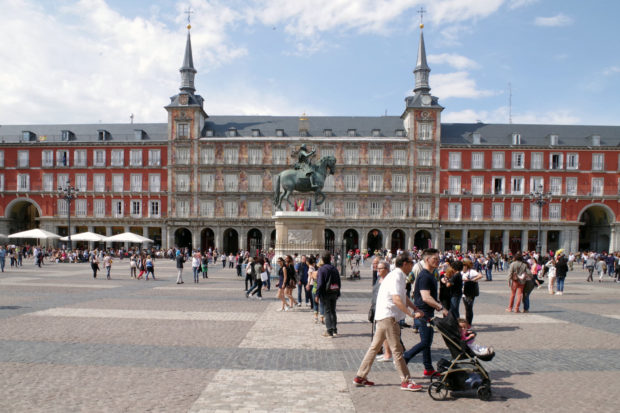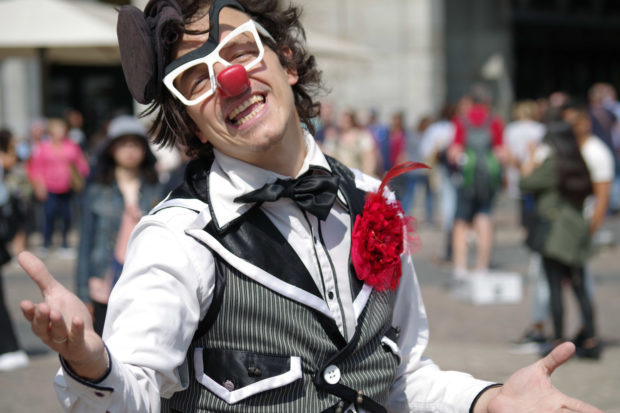You have no items in your cart. Want to get some nice things?
Go shopping
To wash away the blood of bulls and heretics, a trio of Hispano-Bretones draw six tons of bronze from the Casa de Campo. The drayman’s bow legs curl around the bay’s barrel chest as he urges the team forward with both shouts of “¡Arre!” and a battered straw sombrero that he waves over their shoulders. The other drayman drives them on with a long whip, cracking it between the horses’ ears. They snort and stamp, and the ropes snap taut as they take the strain of Phillip the Pious’ statue. Tethered to a sled of pine trunks from the Valle de la Fuenfría, it ploughs deep furrows through the fields on its way to the city.
The statue was brought from the countryside nearly two centuries ago to bring distinction to the Plaza Mayor, and far off in the centre of the plaza, he cuts a reverential figure through the gloom. His bastón de mando is as upright as his back, his eyes are set squarely over his horse’s ears to the Puerta de la Calle Zaragoza, and his face is muffled to the chill of the Madrid morning by the starched folds of a bronze ruff, that serpentines up and down, around his neck.
Lines of verdigris run along the well-defined flanks of his muscular horse, etched by tears. Though bullfighting and the Inquisition’s tortures and immolations are no longer a part of the plaza’s sideshow, they’ve been replaced by rock concerts, royal weddings, a Minion, Chucky, clowns, and charlatans, who ply their trade around the equestrian bronze.
I’d escaped the icy chill of the plaza, in the Cevecería Plaza Mayor. Through the bar’s windows, wet with condensation, the elements of the radiant heaters burn with an incandescent orange glow; magnified by the beads of moisture they appear to burn even more intensely. But they’re fixed so high, it’s clear that only the ceiling will benefit. They barely warm the top of my head, my coffee is tepid, and my toast cold, so I sit uncomfortably in an overcoat, scarf, and one glove on my left hand, and try to warm the white fingertips of my right hand, around the cup of coffee; the blood stubbornly refusing to return from where it came.
Madrid is at the centre of the Spanish Meseta, which covers nearly half of Iberia; the vast plateau is lined with a handful of sierras. During the coldest season, icy winds blow from their snow-capped peaks, and channelled between the Sierra Guadarrama and Montes de Toledo, chill the capital city. Winter. Madrid is the coldest place in Spain, and today nobody argues otherwise. For six months the people of Madrid protest how hot it is… “¡Uff que calor!” and for the remainder of the year, how unbearably cold it is; but Madrid is neither a river of ice nor an arid desert, and they’re simply taking pride in their own resilience, enduring the extremes of a very particular climate.
A few delivery vans arrive in the plaza. Visible through drips that trickle through the condensation, their drivers wrapped in woollen scarfs, puffy jackets, and tip-less gloves, work with haste in the glacial frost. They blow repeatedly, warming numbed finger or easing the discomfort of breathing chilled air. Their exhalations rise like steam puffed from the funnel of a locomotive as they go backwards and forwards across the plaza with their porter’s trollies, stacked with sacks, boxes, crates, and kegs.
Clouded by a frosty haze the colourful splendour of Habsburg Spain is flat and grey. But there’s still a couple of hours till the sun breaks over the Puerta de la Calle Zaragoza, burns off the frost, and casts shadow and colour over everything. And with the sun edging higher, Phillip the Pious faces the first street entertainer, suspecting that the comical Peruvian is not here for sightseeing. He’s pushing a wooden cart across the plaza, carrying a headless bullfighter and flamenco dancer. There’s little chance he’ll arrive unnoticed, as the wheel’s forged iron rims soundlike a pair of coarse granite millstones that grind away as they scrape over the basalt paving.
He senses a reproach from the statue, as he places both figures against its plinth, and prepares the camera for portraits. To avoid the awkwardness of the moment he squawks at Phillip the Pious like a black capped parrot, twisting the bullfighter’s hat so it resembles a beak, and flapping his elbows like wings. He might have equally roosted on the statue’s head and dumped his load with a lack of civility that would have shamed the diabolos. For now, there’s no one to appreciate his buffoonery, but he won’t have to wait long.
The first chain of hire bicycles and Segways arrive, their riders looking awkward in streamlined fluorescent helmets, not yet accustomed to their own conspicuousness. The polycarbonate shell, a whirlwind of vivid yellow convolutions, is a chic fascinator that sits a little above their heads and is fastened with a broad black chinstrap. As they leave, they’re joined together like a self-conscious centipede sensing their individuality is best sacrificed for collective comfort. And as a Minion, Chucky, Rubble and a strange psychedelic goat upstage their departure, the Peruvian sensing their unease lets out a few more squawks to send them on their way.
The goat has a glittery pelt, honks, clacks its mouth like a pelican, bleats like a sheep, and rings a brass bell on a chain hung between its horns. Improbably, a dapper African is the most sartorially unadventurous character in the plaza. In a black kufi decorated with gold braid, turquoise dashiki, and red Nike trainers, he flourishes above his head not spears, but selfie sticks.

He hassles a priest in full black cassock, from the Puerta de la Calle de Toledo; first one side, then the other, skipping around his back like a Zulu warrior dancing an Imdlamu. But it should be evident even to the African that the priest is in no need of a selfie stick, it’s not his job to be self-conceited, to the contrary. He walks without deviation to the Casa de la Panadería on the opposite side of the plaza, as though the African isn’t there, his path as straight as the tensioned wire of a tightrope walker, his steps as true, and his concentration equally focused.
Rucksacks packed with sound systems play reggaetón, hanging from the backs of babbling teenagers crossing the plaza,lost in their own babel. Posterity demands children are photographed by the Minion, Chucky, or Rubble, though they avoid the psychedelic goat, and a girl is drawn by a cartoon artist. Her boyfriend looks on as he draws his regular set of features; aquiline nose, bulging eyes, and horse’s teeth that burst from her mouth; features that, though he has an intimate knowledge of her face he’d previously been unaware of.
And with the sun now at the zenith, the frosty haze might have been an atmospheric chimera that never really happened, as El Alquimista de Sonido, opens the brass clasps of a glossy red cello case in a corner towards the Puerta del Sol. He takes out a full octave of hotel bell pushes and Velcro’s them to his shoulders, hips, knees, and buttocks. He slaps around like a Bavarian in lederhosen, dancing the Schuhplattler; the last chord of the Strauss waltz played with an exaggerated slap to both knees.
Otherwise he attaches seven antique automobile horns around his body, each tuned to a note. The range complemented by five cow bells rung by those from the crowd. He now has twelve distinct notes to choose from. He’s a conductor masquerading as a white-faced clown, though lacking a baton and five competent musicians. He wears a ragged tuxedo, his own tousled hair under a tiny top hat squashed like a pancake, and pins over his heart a fulsome red rose that complements his long red nose and extravagantly elongated clown shoes. Pointing, he cajoles his inept chamber orchestra to provide him with the right notes at the correct moment, whilst he pinches the rubber hooters, or squeezes them in his armpits like a clucking chicken, and together they play Vivaldi’s Four Seasons.
With only one to hand it’s not possible for them to play the wrong note, but his campanologists are sometimes a little late, a little early, ring at the wrong moment entirely, miss his cue, or tinkle the cow bell ineffectually. He stops, tilts his head, puts hands on hips, crosses his arms, and looks at the offender without the necessity to say “¡Joder! Even a cow can do it.” He glances towards the crowd who cackle away, as though the clown had opened a tin of canned laughter, and eventually the Four Seasons are played to a perfection, that lacking flute, oboe, violin, viola da gamba, cello and spinet, seven automobile horns and five unsuspecting tourists with a cow bell will allow.
He plays the crowd as deftly as he plays his improvised instruments, encouraging them to squeeze his horn, or ring his bell, turning them on or off like a switch. He alternates between self-deprecation and mockery; the crowd his auguste eager to make fools of themselves. He controls the unpredictable, taking advantage of the youngster with a sticky lolly who unaware toddles across his stage, or those who rudely shout across his performance, whilst chiding patrons of the expensive restaurants around him, who are cawing like an unkindness of ravens. The plaza approaching lunchtime is a bizarre big top with a ragbag circus of clowns, and no ringmaster.
Leaving through the Puerta de Ciudad Rodrigo with the sun on my back and my overcoat over my arm, a young girl probes Fat Spider-Man as to the authenticity of his fatness. “You’re fat?” she says, with a finely balanced mixture of accusation and doubt. Amused by his belly that rolls around within his red and blue onesie, she pokes her tiny finger into his gut. It’s true, there’s a certain unevenness to its rotundity.
Evidently his career would be over, should by any unforeseen circumstance he lose weight. The very foundation of his livelihood dependent on overeating and the necessity to drink a lot of beer. So like a professional athlete – but equally to the contrary – should he inadequately prepare himself and therefore lose weight, he might be tempted to push some padding under his nylon spandex.
He chooses to avoid the issue, ignores the young girl’s claim, and replies in a Texan drawl, “Madrid welcomes you!” and adds, should the girl doubt that a superhero would, “Spider-Man loves you!” at the same time passing her mother his social media accounts printed on a business card.

About Tim harris
Tim, a designer from London, chose to develop his writing and photography in a remote Spanish village in Extremadura. Here he publishes artisanal books of his work, as Beyond the Duero, that also take advantage of his creative expertise. He’s lived not just in the UK and Spain but also Mumbai and Doha, all of which feeds his fascination for showing the idiosyncrasies of people and places.
- Web |
- More Posts(1)




